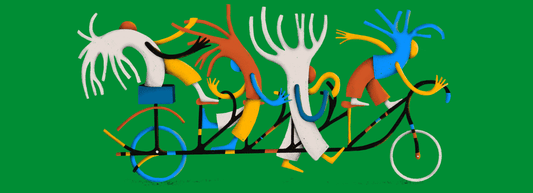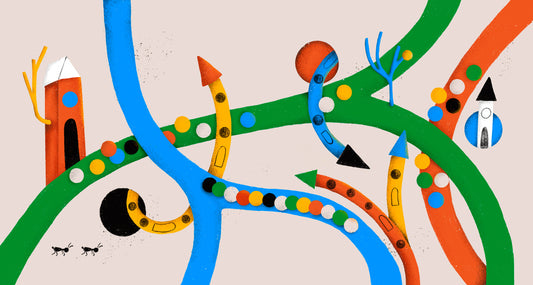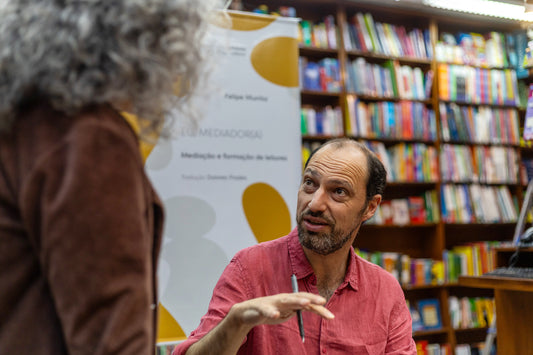Há 50 anos, Enéas Guerra vem desenhando com traços fortes sua carreira. Ao longo dessa trajetória, são incontáveis projetos gráficos desenvolvidos.
Com a versatilidade que lhe é característica, o artista visual de 72 anos já fez quase tudo o que sua área de atuação permite: cenários de peças teatrais, identidade visual para empresas, trabalhos para agências de publicidade, HQ para potencializar o turismo baiano, marca e sinalização do Hospital Sarah Kubitschek de Brasília, capas de discos, cartazes para espetáculos culturais, muitas ilustrações, e é claro, livros. E teve até trabalho censurado pela ditadura militar! Uma riqueza de acervo, que se encontra com a história da arte gráfica contemporânea.

Convidamos o leitor a conhecer um pouco mais sobre o artista gráfico nascido em Botucatu, criado em Ribeirão Preto (ambas cidades do interior de São Paulo), mas que se encontrou mesmo foi na Bahia, com as bênçãos da ialorixá Mãe Stella de Oxóssi (1925-2018) e do etnólogo e fotógrafo francês Pierre Verger (1902-1996). Aqui, ele constituiu família e toca, junto com a esposa e editora Valéria Pergentino, e o filho Kin Guerra, a Solisluna Design Editora, que este ano completa 30 anos.
- Me fale um pouco sobre o pequeno Enéas: já gostava de desenhar? Alguém da sua família era da área artística?
Toda criança desenha, à medida que cresce vai deixando de desenhar. Eu não parei de desenhar. Fiz escolinha de arte aos oito anos de idade. Eu tenho um irmão que é fotógrafo. Minha mãe foi professora primária durante 39 anos e meu pai era serventuário da Justiça. Tenho uma irmã museóloga, outra que trabalha com arte-educação, ligada à pedagogia Reggio Emilia, e uma outra irmã que é dentista, e que diz que também é artista (risos).

- Quando você se entende como desenhista?
Quando eu começo a ir mal na escola (risos). Ficava desenhando em sala de aula. Mas isso eu não contava pros meus filhos (tenho quatro: Nemo, Athos, Ian e Kin, todos artistas). Com 15 anos eu fiz a cenografia do espetáculo, 'Pluft, o Fantasminha' (Maria Clara Machado), em Uberaba, Minas Gerais. Eu passava as férias em Minas e conheci um pessoal do teatro. Foi aí que comecei a me envolver com essa área. Com 17 anos, trabalhei quatro meses em uma agência de propaganda, em Ribeirão Preto (eu nasci em Botucatu, mas, quando tinha três meses de idade, meus pais foram morar em Ribeirão Preto). Com 18 anos fui morar em São Paulo. Era final da década de 60, vivi em comunidade, era arte pura! Prestei vestibular para a ESPM e passei. Estudava à noite e de dia trabalhava com arte. Foram anos difíceis e marcantes. Aos 19 anos, fui preso pelo DOI-CODI (órgão de repressão e censura da ditadura militar) junto com alguns amigos.

- Como foi essa experiência?
Eu estava na casa de um amigo, com meu irmão, e mais uma outra pessoa que morava na casa, no bairro de Pinheiros. A casa era muito frequentada por jovens estudantes. De repente, bateram na porta e entraram uns caras armados, que levaram a gente pro DOI-CODI. Fiquei três ou quatro dias preso. Não me bateram e nem me torturaram, mas foi uma experiência muito ruim, muito tensa, porque você não sabe o que vai acontecer. Liberto junto com meu irmão fomos direto pro Rio de Janeiro, para a praia de Piratininga em Niterói. Lá, chegamos em uma casa onde, ao lado, tinha músicos de uma banda ensaiando um repertório super agradável. Costumo dizer que fui do inferno ao céu! (risos)
- Quais eram suas referências?
Pintores clássicos, modernos, bem como a literatura. Era a época da contracultura. O Brasil tinha o Cinema Novo, a Bossa Nova, era um período de muita efervescência cultural. Fui convivendo com tudo aquilo e as coisas foram acontecendo. Conheci o antropólogo Roberto Pinho que me convidou a vir trabalhar na Bahia. Eu estava concluindo o curso na ESPM em São Pauloe quando terminei vim direto para a Bahia no dia 25 de março de 1973.
- Como foi deixar São Paulo e vir para Salvador?
Eu tenho raízes nordestinas. Meu avô materno é de Palmeiras dos Índios, Alagoas. Quando cheguei em Salvador, me senti em casa, como se fosse daqui. Comecei a fazer trabalhos para a Bahiatursa (antiga Empresa de Turismo da Bahia), para agências de propaganda, cenografia e cartazes para espetáculos de teatro, música e dança. Em 1976, fiz um cartaz para uma exposição de fotografia de Pierre Verger.
Tinha muita coisa interessante acontecendo em Salvador nesta época, muitas manifestações populares. Passei 5 anos intensos em Salvador, conhecendo sua cultura e sua gente e trabalhando muito. Mas em 78 e 79 eu fui morar em Brasília, para trabalhar no Equiphos, centro de pesquisas e projetos do Hospital Sarah Kubitscheck, também a convite de Roberto Pinho (meu amigo até hoje). Trabalhei desenvolvendo junto a uma equipe de designers o projeto de sinalização para o hospital, e a montagem de uma pequena gráfica, e na ocasião fiz também a marca do hospital.
- Nesse período, o rock de Brasília dava seus primeiros passos...
Sim. Um colega designer que trabalhava comigo no Sarah, me apresentou muita gente incrível. Fiz cartazes para a icônica Galeria Cabeças, responsável pelos eventos de música, "Concerto Cabeças ao Ar Livre", que acontecia no gramado atrás da galeria. Os eventos eram sempre no último domingo de cada mês e aconteceram no final dos anos de 1970 até o final dos anos 1980. Os shows eram de bandas de rock como Paralamas do Sucesso, Legião Urbana, Capital Inicial, ainda em começo de carreira.
- Mas também teve uma história com a censura?
Sim, eu fiz um cartaz para uma peça de um grupo de teatro e dança, chamada 'O Noviço', de Martins Pena, e a Polícia Federal apreendeu o cartaz. O cartaz era ilustrado com o personagem central da peça, um noviço de batina preta, que eu desenhei caminhando com o membro ereto (risos). Censuraram. Tive que colocar uma tarja informando que a peça era para maiores de 18 anos. Eu coloquei a tarja em cima do membro do rapaz e foi liberado (risos).
- Em que ano você voltou para Salvador?
Em 1980. Foi quando o Pierre Verger estava voltando da África. Ele ainda não tinha nenhum livro publicado no Brasil. Um grupo, do qual fiz parte, criou a Editora Corrupio e decidimos lançar o livro 'Retratos da Bahia', com fotografias de Verger de 1946 a 1952. Nessa época, eu ainda trabalhava na Prefeitura de Salvador (na assessoria de comunicação), de dia, e, à noite, como ilustrador no Jornal da Bahia.
- Como foi trabalhar em redação de jornal?
Foi muito bom, bastante diferente, principalmente a convivência com as equipes de jornalistas, vários deles são meus amigos. Ainda da época do Jornal da Bahia, quando estava para encerrar as atividades, consegui resgatar uma boa quantidade de desenhos que produzi, um acervo de ilustrações em bico de pena; marcaram uma época.

- Como é o seu processo de criação?
Para cada tipo de trabalho, eu tenho uma dinâmica diferente. Quando tenho um desafio para criar uma ilustração, aquilo fica na minha cabeça. Às vezes eu risco, às vezes, escrevo uma palavra ou uma frase. Para produzir os livros, tenho que me familiarizar com o conteúdo, ler o texto, ver o que ele direciona. Algumas vezes, até o título do livro já sinaliza. A pressão de produzir em um tempo exíguo também influencia.
- Qual foi o projeto mais difícil que você realizou?
Tem vários, mas um deles é o livro 'Orixás', porque tem toda uma história de 40 anos de pesquisa do Verger. Trabalhei dois anos com Verger neste projeto editorial. E eu precisava fazer todo aquele valioso conteúdo ficar legível para o público, sem descuidar da estética.

- Como foi essa troca com Pierre Verger?
Nós tínhamos reuniões regulares, ele dizia o que queria, a gente batia uma bola e compartilhava ideias. Ele era sempre muito respeitoso com o meu trabalho e com as minhas propostas. Foram dez anos de convivência e muito aprendizado. Com Verger publiquei em coautoria os meus primeiros livros ilustrado para crianças, ‘Oxóssi, o Caçador’ e Lendas dos Orixás (Ed. Corrupio, 1981), as primeiras publicações desta natureza no Brasil.
- Ao longo dos 50 anos de carreira, você teve que se adaptar às ferramentas e modos de produção de cada período. Qual foi o maior desafio?
A era digital mudou tudo, as coisas ficaram mais fluidas. Ficou mais rápido para produzir, pra colocar uma coisa de pé. Os programas vão se modificando e ficando melhores.

- Você, então, não é do tipo saudosista e reconhece que as tecnologias otimizam os processos de produção?
Claro. Antes a gente usava fax, telex, os Correios para enviar uma ilustração, um layout para ser aprovado. Hoje em dia temos a internet, o email, o celular. O trabalho chega rápido no seu destino. Tem uma complexidade maior e novos aprendizados, todo dia surge algo novo para se aprender.
- Você acha que existe um valor maior na arte que é produzida de forma ainda manual?
Não. Pra mim, é tudo igual. O fato de ser difícil de produzir não significa que aquela arte seja melhor. Às vezes, é bem o contrário. Na questão do digital para os artistas que sempre trabalharam com o papel, o grande desafio é o aprendizado dos programas, mas uma vez que temos este domínio a tela passa a ser um suporte para nossa arte.

- E como é trabalhar em família (com a esposa, a editora Valéria Pergentino, e o filho, o fotógrafo Kin Guerra)?
Super democrático, tudo conversado, não tem nada imposto. Temos nossas diferenças, mas conseguimos ir avançando, cada um com a sua especialidade. Todos dão opiniões, o trabalho é discutido em grupo e depois caminha com o responsável. Todo mundo contribui, e o resultado é sempre muito gratificante. E além da família de sangue, temos nossa família “Solislúnica”, fundamental para que as coisas aconteçam. A designer Elaine Quirelli está conosco há mais de 20 anos, sempre contribuindo com o seu talento. Nossa equipe de trabalho e a rede de parceiros são muito importantes para o sucesso da Solisluna. Sou grato a todos!

Equipe Solisluna Editora em 2022: Kin Guerra, Enéas Guerra, Mirian Souza, Valéria Pergentino, Elaine Quirelli e Vinícius Maciel.
***
Esta bate-papo entre a jornalista Nilma Gonçalves, a editora Valéria Pergentino e o artista visual Enéas Guerra aconteceu em uma tarde de agosto de 2023 na casa da Solisluna, em Vilas do Atlântico, Bahia.






